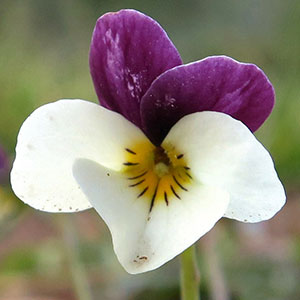Viola hallii
Viola subsinuata
Hall's violet, Oregon violet, wild pansy
early blue violet, wavy-leaf violet, wood violet
1–3, decumbent or ascending to erect, ca. 1/2 subterranean, glabrous, clustered on single, short, vertical, deep-seated caudex.
basal and cauline;
basal: 1–4, palmately compound, ± 2-ternate or 3-ternate, leaflets 3;
stipules adnate to petiole, forming 2 linear-lanceolate wings, unlobed, margins entire, apex of each wing free, acute;
petiole 5–8 cm, glabrous;
blade ovate to deltate, 2.8–6 × 2.6–6.5 cm, ± coriaceous, base tapered, ultimate lobes narrowly elliptic, lanceolate, or oblanceolate, 1–7 mm wide, margins entire, ciliate or eciliate, apex acute, mucronulate, surfaces glabrous;
cauline similar to basal except: stipules usually lanceolate, sometimes broadly ovate, ± leaflike, margins toothed;
petiole 1.3–6 cm;
blade 2–4.8 × 1.2–5.5 cm.
basal, 2–11, ascending to erect;
stipules linear-lanceolate, margins entire, apex acute;
petiole 5–25 cm, glabrous or pubescent;
mid-season leaf blades incised or lobed throughout, earliest leaf blades lobed (plants homophyllous), similar to mid-season blades, blade 5–9(–16)-lobed, sinuses usually narrower, shallower toward leaf base, middle and lateral blade lobes differ in width and/or shape, middle lobes narrowly deltate to narrowly elliptic, lateral lobes narrowly elliptic, lanceolate, or falcate, 1–11 × 1–12 cm, base truncate to cordate, margins entire or crenate, ciliate or eciliate, apex acute, mucronulate, surfaces usually pubescent throughout or on veins.
2.5–11 cm, glabrous.
5–15 cm, glabrous or pubescent.
sepals lanceolate to ovate, margins ciliate, auricles 0.5–1 mm;
petals: upper 2 almost black abaxially, dark reddish violet adaxially, lower 3 pale yellow, cream, or ± white, lateral 2 bearded, with deep yellow to orange patch basally, dark reddish violet-veined, lowest with deep yellow to orange patch basally, dark reddish violet-veined, 5–18 mm, spur yellow, gibbous, 0.5–2 mm;
style head bearded; cleistogamous flowers absent.
sepals lanceolate to ovate, margins ciliate or eciliate, auricles 1–2 mm;
petals light to dark blue-violet on both surfaces, lower 3 and upper 2 sometimes purple-veined, lateral 2 bearded, lowest sometimes bearded, 15–25 mm, spur color same as petals, gibbous, 2–3 mm;
style head beardless; cleistogamous flowers on prostrate to ascending peduncles.
ellipsoid, 4–12 mm, glabrous.
ellipsoid, 8–12 mm, glabrous.
light brown, shiny, 3.2–3.5 mm.
beige, mottled to bronze, 1.5–2.5 mm.
= 60, 72.
= 54.
Viola hallii
Viola subsinuata
Viola hallii was discovered on the grounds of Willamette University in Salem, Oregon, by Elihu Hall, a professor at that institution (V. B. Baird 1942). Leaves of V. hallii are similar to V. beckwithii.
(Discussion copyrighted by Flora of North America; reprinted with permission.)
L. E. McKinney (1992) described the misconceptions surrounding Viola subsinuata that many came to think of as the heterophyllous V. palmata, whereas V. subsinuata is homophyllous. As E. Brainerd (1910, 1921) pointed out, heterophylly versus homophylly is an important and steadfast character difference in acaulescent Viola species. N. L. Gil-Ad (1997) chose not to recognize V. subsinuata, suggesting that it represented a hybrid or introgressant. H. E. Ballard (2000) and A. Haines (2011) both recognized V. subsinuata as a species.
Viola subsinuata is a state historical species in Rhode Island, where it was last documented in 1941 (R. W. Enser, http://rinhs.org/wp-content/uploads/ri_rare_plants_2007.pdf).
(Discussion copyrighted by Flora of North America; reprinted with permission.)


